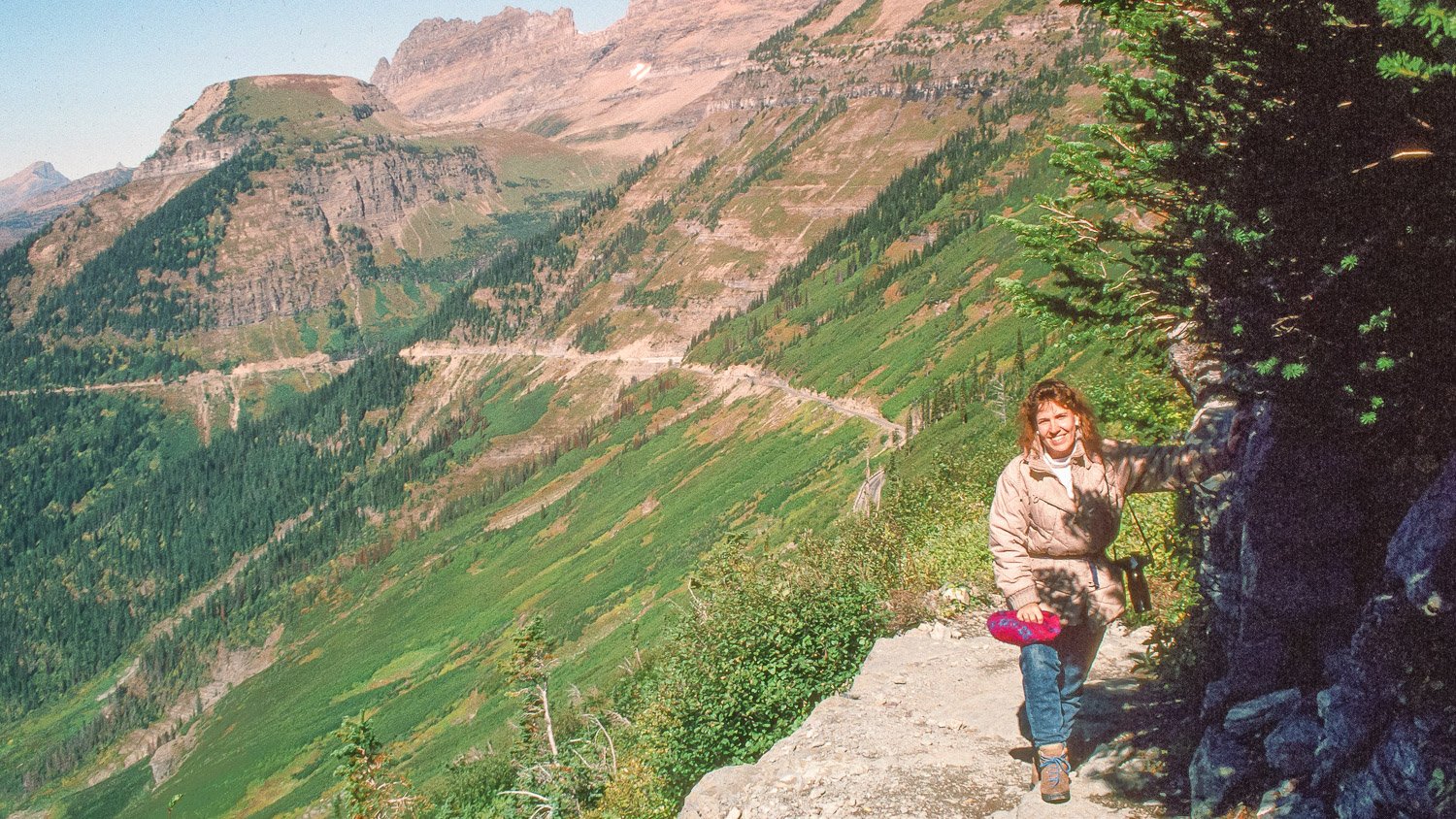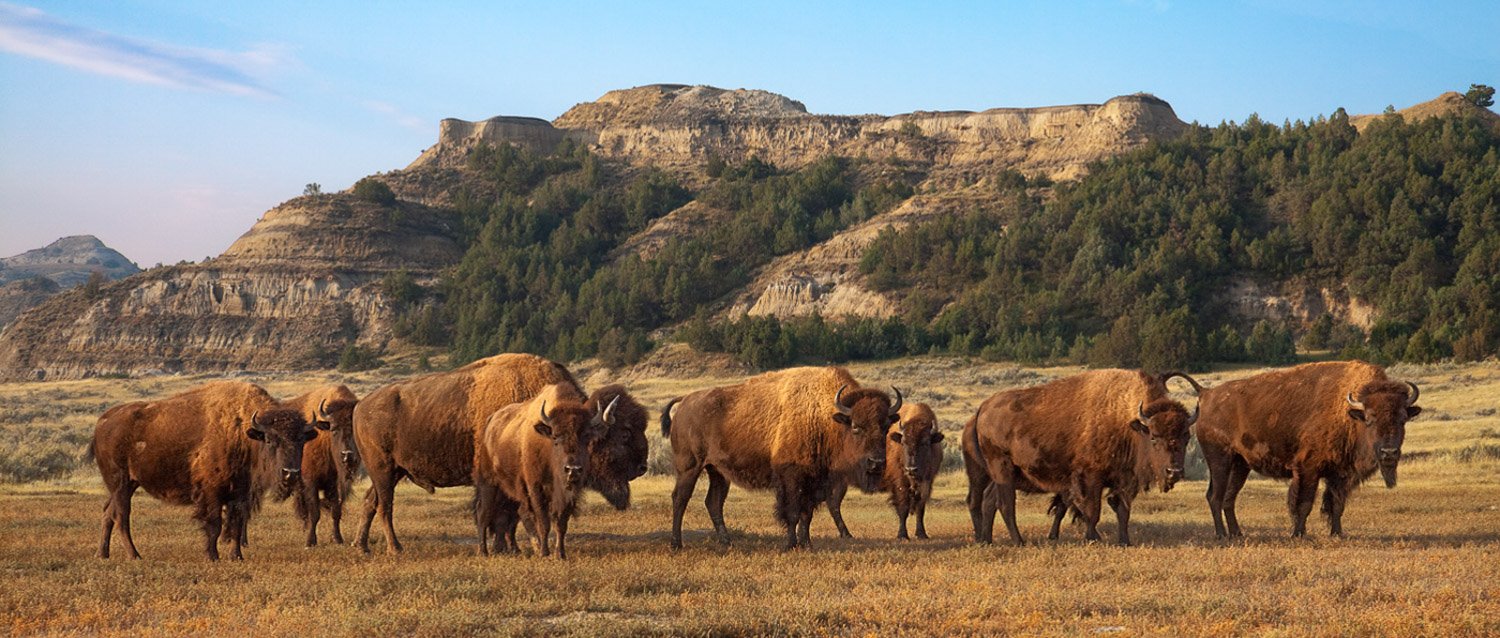While at Yellowstone in 1972, we drove south to Grand Teton National Park for a quick visit and a taste of how spectacular the Rockies could be. We then headed north in Montana to Glacier National Park. When crossing the Going-to-the-Sun Highway, I found what had been a single, spectacular ridge of mountains at Grand Teton were now peaks in all directions as far as you could see. A hike near Logan Pass was filled with blooming flowers, and mom spotted our first grizzly bear. Glacier would fill me with the most majestic landscape on this trip.
Mom & me, Glacier Nat’l Park —1972
Jane and I would visit Glacier in the fall of 1991 with Joe, then nearly two years old. Dan would be born nine months later.
Joe, MacDonal Creek, Glacier Nat’l Park — 1991
On that 1991 trip, we spent two nights in East Glacier and two in Apgar on the west side, and every day had a morning and afternoon hike. The first image below is of Logan Pass with snow still on the ground in July 1972, and the second is on the Highline Trail from near there with early fall colors in September 1991.
Logan Pass, Glacier NP — 1972
Highline Trail, Glacier Nat’l Park — 1991
Glacier’s the park highest on our list to return to, but the logistics of getting there are challenging. However, I’ve returned often to the Montana Rockies through the fiction and non-fiction of my favorite writer Ivan Doig. Travel so often opens the door to wanting to read more about a place, and the books and the visits echo back and forth. Doig’s Ride with Me, Mariah Montana is set in 1989, the centennial year of Montana’s statehood. The narrator greets dawn in the capitol city of Helena. And there I was in the book, and in my mind back to the view I had one sunrise. In 1989 I’d finished a hearing the day before, and we celebrated with a dinner at a restaurant in Last Chance Gulch. I got up before sunrise to hike up a nearby hill above the fire tower, and sat in the grass to watch the city wake. And Doig wrote for me:
“Dawn is when I have always liked life most, the forming hour or so before true day, and that next morning . . . I went out to sit on a picnic table and watch Helena show off its civic ornaments in the daybreak light. The dark copper dome of the state capitol. The Catholic Cathedral’s set of identical twin steeples. . . My favorite, though, stood perched on the high side of Last Chance Gulch, above the historic buildings downtown; the old fire watchtower up on four long legs of strutwork. Like a belltower carefully brought to where it could sound alarm into every street when needed. What a daystarting view it must be from there, out over the spread city and this broad shallow bowl of cultivated valley and the clasping ring of mountains all around.
In what seemed just another minute, the sun was up. That’s the trouble with dawn, it doesn’t last.”
Helena, Montana — 1989
Next, my parents and I visited the National Bison Range a bit south of Glacier on the Flathead Reservation. Managed by the U.S Fish and Wildlife Service, the herd was from the last free ranging bison in the world. The magic for me for was seeing the pronghorn running across the plains among the bison. Dad asked me to get out of the truck to pick up a map and brochure from the nearby kiosk, and as I turned to go back, there was a bison that looked nearly as big as the camper. I snapped away on my Kodak Instamatic.
National Bison Range, Montana - 1972
I thought of that moment when nearly 40 years later, I was laying in the grass in Theodore Roosevelt National Park, alone and miles from anyone, taking pictures of prairie dogs, when a herd of bison surrounded me and decided to graze. I had to stay there, sitting in grass for a very long time, eventually talking in a low voice to the bull staring at me telling him how I’d be quietly walking away. But I got some great images first while thinking, “When am I ever going to get closer buffalo shots than this?”
What was the National Bison Range is now simply called the “Bison Range.” The land and the herd had been taken from the native peoples as part of the Allocation Act early in the 20th century. In 2020, Congress finally passed legislation to transfer management of the range back to the Indigenous peoples in the area. You can watch a fascinating short documentary created just on the verge of this transfer occurring.
Doig’s English Creek trilogy begins with Scottish immigrant brothers setting up their sheep ranch in the foothills of Rockies in the year of the state’s founding. The final volume is set a century later, and Mariah is one of the founding brother’s granddaughter. The cover of is an illustration of Mariah photographing at the Bison Range:
“My heart did some flutters as . . . I listened to her prowling around on that slick metal roof. I mean, oughtn’t here be some kind of hazard rule that a photographer never do anything a four-year-old kid would have the sense not to?
My flutters turned into genuine internal gyrations as the old bull shook off the last smatters of his dust refreshment, stood for a minute with his half-acre head down as if pondering deeply, then began plodding directly toward the motorhome. . .
‘Hey, up there. . . How about coming down in? This old boy looks kind of ornery.’
Answer from on high consisted of a sudden series of whing-whingswhings, like a little machine going. It took me a bit—about four more paces by the inexorable buffalo—to figure out the blurty whing sounds, which kept on and on, as being the noise of a motorized camera Mariah resorted to when she wanted to fire the shutter fast enough to capture every motion. As now. ‘You’ve got to be kidding,’ her voice eventually came down but of course none of the rest of her. ‘When am I ever going to get closer buffalo shots than this?’
Ivan Doig, Ride with me, Mariah Montana, 1990
Theodore Roosevelt National Park - 2009
We continued west across Idaho into Washington, and I remember being surprised how hot it was. Florida might’ve had hot summers, but I’d never been in 100 degree weather before. The Chevy had no air conditioning, so my right arm was sunburned. Dad did all the driving, so his left arm was burnt, and mom sat in the middle except when I rode laying down in the back camper. I remember spitting Washington cherry pits out the window as we drove the dry plains. We toured the Grand Coulee Dam and the nearby Dry Falls of the Columbia before heading to the Columbia River Gorge National Scenic Area. (To be continued.)








